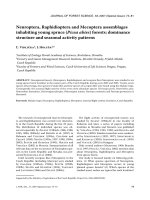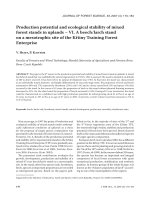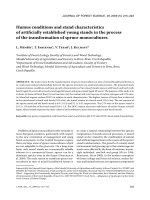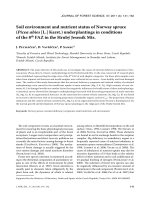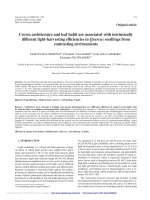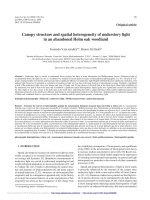Báo cáo lâm nghiệp: "Shoot development and dieback in progenies of Nothofagus obliqua" pptx
Bạn đang xem bản rút gọn của tài liệu. Xem và tải ngay bản đầy đủ của tài liệu tại đây (444.23 KB, 6 trang )
Ann. For. Sci. 64 (2007) 839–844 Available online at:
c
INRA, EDP Sciences, 2007 www.afs-journal.org
DOI: 10.1051/forest:2007068
Original article
Shoot development and dieback in progenies of Nothofagus obliqua
Javier Puntieri
a,b
*
,JavierG
rosfeld
a,b
,MarinaStecconi
b
, Cecilia Brion
a
,
María Marta A
zpilicueta
c
, Leonardo Gallo
c
,DanielBarth
´
el
´
emy
d
a
Departamento de Botánica, Universidad Nacional del Comahue, Quintral 1250, 8400, Bariloche, Argentina
b
Consejo Nacional de Investigaciones Científicas y Técnicas, Argentina
c
Laboratorio de Genética Forestal, Instituto Nacional de Tecnología Agropecuaria, EEA Bariloche, Argentina
d
INRA, Unité Mixte de Recherche CIRAD-CNRS-INRA-IRD-Université Montpellier 2, “ botAnique et bioinforMatique de l’Architecture des
Plantes ” (AMAP), UMR T51 (CIRAD), UMR 5120 (CNRS), UMR 931 (INRA), M123 (IRD), UM27 (UMII) TA A-51/PS2, Blvd. de la Lironde,
34398 Montpellier, Cedex 5, France
(Received 29 December 2006; accepted 23 May 2007)
Abstract – Shoot growth and dieback were compared among progenies of nursery-grown seedlings of Nothofagus obliqua belonging to seven progenies
of the same provenance (Quila-Quina, Argentina). First-year shoots consisted of one growth unit (GU) and second-year shoots of one or two GUs. The
probability of development of two GU was similar for all progenies. Progenies were different in terms of shoot size, terminal bud abscission, the extent
of shoot dieback after shoot extension and the node of origin of the relay shoot on the first shoot. Plants with a second-year shoot consisting of two GUs
had a thicker stem and more nodes than those with single-GU shoots. The selection of N. obliqua seed trees based on architectural traits suitable for
forestry development at specific sites must contemplate variability among progenies and their probabilities of successful development under different
conditions.
shoot dieback / gr owth unit / plant architecture / progeny / Nothofagus
Résumé – Développement et dépérissement des pousses de descendances de Nothofagus obliqua. La croissance et le dépérissement des pousses
ont été comparés entre sept descendances de Nothofagus obliqua élevées en pépinière et issues d’une même provenance (Quila-Quina, Argentine). Les
pousses de la première année n’étaient formées que d’une seule Unité de Croissance (UC) tandis que les pousses de deuxième année étaient constituées
d’une ou deux UCs. La probabilité de développement d’une deuxième UC était constante quelle que soit la descendance. Les descendances ont montré
des différences en termes de taille de pousse, d’abscission du bourgeon terminal, d’étendue de dépérissement des UC en fin d’extension et vis-à-vis du
nœud d’origine de la pousse relais sur la pousse de première année. Les plantes avec une pousse de seconde année comportant deux UC avaient une tige
plus épaisse et avec plus de nœuds que celles avec des pousses à une seule UC. La sélection, basée sur des traits architecturaux, d’arbres de N. obliqua
issus de graines, pour qu’elle soit adaptée à la foresterie, doit prendre en compte la variabilité entre descendances et leurs probabilités de réussite et de
bon développement sous des conditions diverses.
dépérissement des pousses / unité de croissance / architecture des plantes / descendance / Nothofagus
1. INTRODUCTION
Trees may respond to different environmental conditions
through morphological and/or physiological mechanisms [5,
12]. The knowledge of genetic components involved in these
responses is useful especially in the case of valuable forestry
tree species. The South American deciduous species Nothofa-
gus obliqua (Mirb.) Oerst. and N. alpina (Poepp. et Endl.)
Oerst. (Nothofagaceae) are considered suitable broadleaf al-
ternatives to conifers for timber production in temperate re-
gions due to their timber quality and growth rate, as shown
in forestries established in Europe in the second half of the
20th century [6, 7, 33]. Both species, but especially N. obli-
qua,suffer from the death of distal shoot segments (shoot
dieback), allegedly after frost damage [6]. Selection programs
on N. obliqua aimed at improving productivity have been de-
* Corresponding author:
veloped only in recent years [13] and plants from different
geographical areas and/or mother trees have been genetically
characterised [11, 18]. Nonetheless, the possible relationships
between the genetic structure of N. obliqua plants and their
susceptibility to the factor/s causing dieback have not been in-
vestigated so far. The architectural analysis (sensu Hallé et al.)
[14] of genetically identified progenies may help to visualize
the link between genetic and developmental traits and to con-
tribute in the selection of seed trees for forestry establishment.
Nothofagus obliqua has a relatively wide ecological ampli-
tude and a large natural distribution area (about 1000 km lati-
tudinally and 200 km longitudinally; from 33
◦
Sto41
◦
30’ S in
Chile and from 36
◦
49’ S to 40
◦
11’ S in Argentina). However,
its current distribution is highly fragmented as a consequence
of glaciation events, volcanism and, more recently, human in-
tervention [10]. Its fruits have a poor dispersal capacity, which
restricts genetic interchange among populations and increases
the risk of genetic losses after local deforestation [8, 10]. In
Article published by EDP Sciences and available at or />840 J. Puntieri et al.
order to examine the morpho-architectural variability of N.
obliqua populations from Argentina, a common garden plan-
tation of provenances was established [28]. The results of this
trial indicated that some traits are influenced by provenance,
e.g. the size of the first-year shoot (an annual shoot is de-
fined as an axis segment developed in one growing season)
and the development, in the following years, of annual shoots
consisting of two or three growth units (GU; defined as an axis
segment resulting from an uninterrupted extension event). On
the contrary, provenances overlapped notably regarding other
traits such as the extent of shoot dieback after extension as well
as the size reached by one- and two-year-old plants [28]. The
present study reports the results of a progeny trial established
at the same time and in the same nursery as the aforementioned
provenance trial. We tested the hypothesis that seedlings of
half-sib progenies within a provenance would display different
shoot growth and dieback in their first two growing seasons.
2. MATERIALS AND METHOD
2.1. Experimental design
Achenes were manually collected from seven N. obliqua trees at
the natural forest of Quila-Quina, the southermost population of this
species in Argentina (40˚ 10’ 40” S, 71
◦
26’ 37” W; 983 m s.n.m.).
The sampled trees were at least 100 m apart from other N. obliqua
trees. Due to the small size (∼ 1 cm long) and disperse location of
fruits in each tree, accessibility to fruit-bearing branches was deci-
sive for tree selection. Achenes were sown in containers in Septem-
ber 2000 (early spring) and, after the development of the first green
leaves, seedlings were installed directly on soil in the tree nursery be-
longing to the “Unidad de Genética Forestal” of INTA EEA Bariloche
(Argentina; 41
◦
07’ 15” S, 71
◦
15’ 06” W; 770 m s.n.m.), about
150 km south of Quila-Quina. The nursery soil was made by mix-
ing the natural soil of the site (volcanic ash and fluvial deposits) with
fine-grained forest debris. Irrigation was provided daily. No artificial
light sources were used. The nursery is surrounded by 20–30 m tall
trees located about 10 m from the nursery borders, which reduced the
hours of direct sunlight on the nursery.
Differences among the seven progenies in fruit availability and
seedling mortality after germination conditioned the numbers of
seedlings available for this study. In each of three independent blocks,
15 to 20 seedlings per progeny were arranged in rows within one
plot (thus, a total of 45 to 60 seedlings per progeny were included).
Distance between blocks was 50 cm and that between neighbour
seedlings 15 cm. One row of N. obliqua seedlings not included in
the experiment was established around each block, so as to mini-
mize border effects. The plot of plants of each progeny was randomly
placed within each block (randomized complete blocks design). This
arrangement, rather than a completely random distribution of plants
within each block, was chosen in order to facilitate the identification
of progenies, some of which were to be included in a longer-term
field experiment after this trial.
2.2. Measurements on seedlings
The vertical axis or trunk of all plants was measured in spring
2002, after the completion of two growing seasons: 2000–2001 and
I II
Figure 1. Diagrammatic representation of the most common struc-
tural types of the vertical axis of two-year old N. obliqua seedlings.
(A-F): Group I, the second shoot consists of one growth unit. (G-I):
Group II, the second shoot consists of two growth units (leaves and
lateral branches not drawn). (A, D and G): the second-year shoot de-
rived from the first shoot’s terminal bud. (B, E and H): the second-
year shoot derived from an axillary bud after the abscission of the
first shoot’s terminal bud. (C, F and I): the second-year shoot derived
from an axillary bud after terminal bud abscission and dieback. Stem
segments and terminal buds that persisted after extension are white-
filled and dead stem segments black-filled. Arrowhead: position of
the cotyledonary node. = Limit between first-year and second-year
shoots. A series of short black dashes represents the sequence of short
internodes at the base of each growth unit.
2001–2002. For each plant, shoots and GUs were identified non-
destructively using morphological criteria [2, 25]. In N. obliqua,the
limit between two GUs of a shoot is clearly recognized by the pres-
ence of a set of 2 to 5 short internodes (< 1 mm in length) between
two sets of longer internodes (> 5 mm in length; Fig. 1).
Each plant’s basal diameter was measured to the nearest 0.1 mm
with a digital calliper at the cotyledon level. The number of nodes
bearing green-leaves was used as a measure of size for first-year
and second-year GUs of each plant. Cataphyll-bearing nodes at shoot
bases were not considered as they are separated by very short intern-
odes, so that their counting on standing plants is inaccurate. In this,
like in other Nothofagus species, a terminal bud may develop after
GU extension. However, the death of a GU’s terminal bud occurs fre-
quently, leaving a recognizable scar on the stem [28]; throughout this
text, this condition will be described as terminal bud abscission.The
death of distal nodes and internodes of a GU may occur together with
terminal bud abscission, a condition referred to here as dieback.Since
no pruning was applied to the plants, the dead segment of each GU
was standing at the time of measurement (Fig. 1). For each GU of
each plant we registered the presence of a terminal bud and, in case
dieback occurred, the number of dead distal nodes/internodes after
extension. The node of the first shoot from which the second-year
Shoot growth and dieback in Nothofagus obliqua 841
trunk shoot developed was also recorded (counted from the cotyle-
donary node). In case the first-year shoot’s terminal bud persisted and
gave rise to the second-year trunk shoot (Figs. 1A, 1D and 1G), the
position of the latter shoot was quantified by adding 1 to the number
of nodes of the first-year shoot.
The following descriptors were compared between progenies for
first-year GUs: (1) proportion of seedlings with terminal bud abscis-
sion, (2) total number of nodes, (3) the ratio [number of dead distal
nodes] / [total number of nodes], henceforth termed dieback frac-
tion (DF), (4) the ratio [second-shoot position] / [(total number of
nodes of the first shoot) – (number of dead nodes of the first shoot)],
hereafter termed second shoot position (SSP). For second-year shoots
comparisons among progenies included: the proportion of plants with
two GUs and descriptors (1) to (3). Variables concerning the number
of nodes of second-year shoots were compared separately for the first
and the second GUs and for the sum of both GUs.
Two measures of plant size after two growing seasons were com-
pared among progenies: diameter at the cotyledon level and number
of nodes (adding the total number of nodes of first and second shoots
and subtracting the numbers of dead nodes of each of these shoots).
2.3. Data analyses
Plants with 1-GU second shoot (297 plants, all progenies pooled)
will be referred to as group I plants, and plants with 2-GUs second
shoot (43 plants) as group II plants (Fig. 1). The proportion of first-
year and second-year GUs with terminal bud abscission and the pro-
portion of second-year shoots consisting of two GUs were compared
among progenies by means of χ
2
tests [30]. Comparisons among pro-
genies regarding terminal bud abscission were only performed on
group I plants due to the relatively low numbers of group II plants.
Differences among progenies were assessed through analysis of
variance (ANOVA), including progeny and block as random factors
[20, 30]. A 95% significance level was adopted in all comparisons.
3. RESULTS
3.1. First-year shoots
For group I plants, the percentage of first-year shoots with
terminal bud abscission differed among progenies (between 53
and 94%; χ
2
= 26.8, p < 0.001). In the case of group II, this
percentage ranged between 33% and 100% for the different
progenies. Similar percentages of group I (83.5%) and group II
(72.1%) plants (all progenies pooled) had a first-year shoot
with terminal bud abscission (χ
2
= 2.8, p > 0.05).
For the first-year shoot, significant differences among pro-
genies were detected for the total number of nodes, the DF,
and the SSP (Tab. I). On average, the first shoot of group II
plants had more nodes than that of group I plants (Figs. 2A
and 2B).
When considering the seedlings of all progenies, first-year
shoots with a terminal bud (N = 53) had a similar number of
nodes than those with terminal bud abscission and no dieback
(N = 173; F = 1.1, p > 0.05; three-way ANOVA, including
progeny and block as random factors; after pooling all proge-
nies and groups I and II).
Table I. Mean squares (MS) and Fisher’s F-test for the effect of
progeny (seven levels) after two-way analysis of variance (block ef-
fect not shown) on the following variables of first-year and second-
year shoots and two-year plants: number of nodes per GU (nodes),
dieback fraction (DF), second shoot position (SSP), stem diameter
at the cotyledonary node (diam), number of nodes of two-year old
plants after subtracting dead nodes (Tnodes).
Progeny effect
Va ri ab le M S F
1st shoot Nodes 116.7 11.7 ***
DF 0.22 5.8 ***
SSP 0.07 2.8 **
2nd shoot Nodes
1
62.3 1.6 ns
DF
1
0.57 7.3 ***
nodes
2
121.7 3.9 **
DF
2
0.51 6.7 ***
Two shoots Diam 52.5 11.2 ***
Tnodes 348.8 6.7 ***
Subscripts 1 and 2 for the second shoot indicate that the first GU or the
sum of both GUs, respectively, were compared. *** p < 0.001, ** p <
0.01, ns: p > 0.05.
3.2. Second-year shoots
All progenies were similar regarding the percentage of
second-year shoots with two GUs (between 4 and 17%; χ
2
=
12.2, p > 0.05), and the percentage of dead terminal buds in
group I shoots (41 to 68%; χ
2
= 7.7, p > 0.05). Almost all
group II shoots had terminal bud abscission after the exten-
sion of the first GU; only one plant produced a second, though
axillary, GU without terminal bud abscission. The percentage
of second GUs with terminal bud abscission varied between
50 and 90% for different progenies.
Significant differences among progenies were found regard-
ing the DF of the first GU but not for the total number of
nodes; for both variables group I plants had higher means than
group II plants (Figs. 2A and 2B). The total number of nodes
and the DF of the second shoot after considering both GUs in
case of group II plants also differed among progenies (Figs. 2A
and 2B).
Second-year shoots derived from the terminal bud of the
first-year shoot had, on average, four more nodes than those
derived from an axillary bud of first-year shoots with termi-
nal bud abscission and no dieback (F = 13.4, p < 0.001; in-
cluding progeny and block as random factors; all progenies
and groups I and II pooled). The latter difference was nulli-
fied when the number of dead nodes of the second shoot was
subtracted (F = 0.5, p > 0.05). Similar proportions of second-
year shoots of terminal and axillary origin consisted of two
GUs (χ
2
= 1.8, p > 0.05).
3.3. Two-year main-stem development
The basal diameter and the number of nodes (dead nodes
excluded) of the main stem after two years of growth differed
842 J. Puntieri et al.
Figure 2. (A, B): Mean (+95% confidence interval) number of nodes
(A) and dieback fraction (number of dead nodes expressed as a pro-
portion of the total number of nodes; (B) of the first-year and second-
year shoots of group I (white bars) and group II (black bars) plants;
the means for the first growth unit (GU1) and both GUs (GU1+GU2)
of the second-year shoot of group II plants are shown separately. (C,
D): Mean (+95% c.i.) basal trunk diameter (C) and number of nodes
after excluding the dead nodes (D) for group I and group II plants
after two growing seasons.
significantly among progenies; group II plants had, on aver-
age, a 20% thicker stem at the cotyledon level and a 50%
higher number of nodes than group I plants (Figs. 2C and 2D).
4. DISCUSSION
4.1. Shoot size and dieback
Nothofagus obliqua seedlings derived from different
mother trees of the same population differ, when growing un-
der similar conditions, in the number of nodes and the fate of
the distal end of first-year and second-year shoots. The present
study shows that, at least for N. obliqua, the phenomenon de-
scribed synthetically as apex death involves two components:
the abscission of the terminal bud and the desiccation of dis-
tal nodes and internodes (dieback). The natural abscission of a
shoot’s terminal bud means the death of both apical meristem
and leaf primordia, usually soon after shoot extension [26].
Terminal bud abscission is a more common event in South
American Nothofagus species [2] than in species of other “fa-
galean” genera such as Quercus and Fagus, at least for early
growth stages [3, 15, 16,21]. The factors determining terminal
bud abscission are still unknown. Since the development of
progressively shorter internodes precede terminal bud abscis-
sion [1,2], internal and/or external restrictions to further shoot
growth and terminal bud persistence may be presumed. Recent
studies suggest that terminal bud abscission in Nothofagus is
less likely at the seedling stage than at sapling or adult stages
[31, 34] but is not affected by interactions among nearby buds
[29]. The present study shows that, at least for N. obliqua,ter-
minal bud abscission and dieback may have a genetic compo-
nent. The abscission of the terminal bud of the first-year shoot
without dieback in N. obliqua proved to impact negatively on
the size of the second shoot. This result contrasts with that
of a study on N. dombeyi saplings, in which shoots of termi-
nal and distal axillary origin reached similar sizes [24]. This
discrepancy may indicate a difference between these species
regarding the allocation of resources among the distal buds of
a shoot; age differences between the plants included in both
studies may also be implicated.
In N. obliqua, dieback may occur together with terminal
bud abscission. Shoot dieback in trees has been associated
with stressful environmental conditions [17]. Low water avail-
ability in summer is the major stress factor throughout the dis-
tribution area of N. obliqua, as well as in the area where the
present study was performed [4, 8]. Since water was supplied
all along the experiment reported here, water shortage seems
an unlikely explanation for shoot dieback in this case. Water
supply could act as a growth promoter in this species, so that
trunk shoots of watered plants may be still extending in early
autumn and be exposed to morning frosts, which could then
cause shoot dieback. This idea would agree with the results of
other studies pointing at frost damage on N. obliqua and N.
alpina shoots and its negative effect on the establishment of
forestries with these species in northern Europe, where sum-
mer droughts are uncommon [6, 7, 33].
The development of a relay branch from an axillary bud
after either terminal bud abscission or dieback is frequent in
the trunk of N. obliqua plants. In this study, plants belonging
to different progenies with a low extent of dieback in first-year
shoots tended to develop a second shoot consisting of two GUs
and reached a larger size than those with 1-GU second shoot
(see next section). A more extensive dieback in a first-year
shoot has a negative effect on the size of the plant at the end of
the following growing season. These results support the idea
that buds in different positions have different potentialities in
terms of the size of the shoot they would eventually develop
[1]. In the case of Nothofagus species, such potentialities vary
following a distal-to-proximal decreasing trend in the number
Shoot growth and dieback in Nothofagus obliqua 843
of organs per bud and the number of leaves of fully-extended
shoots [26, 27, 32]. This study suggests that the genetic con-
stitution of trees affects the response of growing shoots to the
death of distal organs. Genetic and ontogenetic factors might
be related to the production of stress-tolerance promoters, as
found for other plant species [19, 23, 35] and suggested by
other studies on Nothofagus [9]. Many of the plants included
in the present study have been transferred to experimental field
populations. The architectural analysis of these plants in the
future would allow the relationships between plant progeny
and growth traits in older plants to be assessed.
4.2. Progeny selection in N. obliqua
A study on N. obliqua seedlings performed in parallel with
the present one and in the same nursery revealed large varia-
tions within provenances (Quila-Quina among them) in shoot
size and dieback [28]. The results of the present study indicate
that such variations may be progeny related and, therefore,
genetically controlled. Both within- and between-provenance
variations are to be considered in the selection of trees with
either conservation or timber production purposes. The selec-
tion of progenies of N. obliqua for forestry purposes must bear
in mind not only the growth potential of each progeny but
also the possible effects of stressful environmental conditions
on each progeny. Severe shoot dieback after extension may
significantly reduce shoot-size differences among progenies.
Plants with main-stem shoots of intermediate size but with
low rates of terminal bud abscission and dieback and a high
frequency of shoots with two GUs would reach a larger size
than those with larger main-stem shoots but higher abscission
and dieback rates. Specific trees might be more suited as seed
sources depending on the region of forestry establishment. The
extension period of long shoots of this and other Nothofagus
species proceeds until late summer and early autumn [24].
These shoots might be more susceptible than shorter shoots
to early frost hazards. Seedlings with a higher tendency to
produce large shoots may be adequate in sites where stress-
ful environmental conditions in late summer are unlikely. In
other sites, plants with shorter shoot-growth duration may be
a more sensible choice.
From the timber production perspective, the absence of ter-
minal bud abscission and dieback after GU extension may be
preferable for the sake of trunk straightness [17]. In N. obli-
qua seedlings, the development of a vertical (relay) branch
following terminal bud abscission affects stem straightness
only in the short term. In all Nothofagus species so far stud-
ied, branching is predominantly pseudomonopodial and most
external signs of terminal bud abscission and a low extent
of dieback disappear few years after relay-shoot development
due to secondary stem thickening [2]. Whether this would be
so in cases of more extensive dieback still awaits evaluation.
The present study shows that those plants with two GUs in the
second shoot had a thicker main stem and more nodes (exclud-
ing dead nodes) than those with single-GU second shoot. This
would imply a mechanically more stable trunk [22] as well as
more potential sites for further growth in the former than in the
latter group of plants. Such traits might be adequate for forest
establishment in windy and/or sloping sites, although experi-
mental testing of this idea is necessary.
Acknowledgements: We are grateful to L. Oudkerk for establishing
and maintaining the plants utilized in the present study, N. Baccalá for
statistical advice and the Administración de Parques Nacionales for
allowing seed collection from conservation areas. This study was sup-
ported by INTA, Universidad Nacional del Comahue (projects B704
and B096) and CONICET, Argentina.
REFERENCES
[1] Barthélémy D., Caraglio Y., Plant morphology and architecture:
a dynamic, multilevel and comprehensive approach to plant form,
structure and ontogeny, Ann. Bot. 99 (2007) 375–407.
[2] Barthélémy D., Puntieri J., Brion C., Raffaele E., Marino J.,
Martinez P., Morfología de las unidades estructurales y modo de de-
sarrollo básico de especies Patagónicas de Nothofagus (Fagaceae),
Bol. Soc. Argent. Bot. 34 (1999) 29–38.
[3] Collin P., Badot P.M., Millet B., Croissance rythmique et
développement du chêne rouge d’Amérique, Quercus rubra L., cul-
tivé en conditions contrôlées, Ann. Sci. For. 53 (1996) 1059–1069.
[4] Conti H.A., Características climáticas de la Patagonia, in: Correa
M.N. (Ed.), Flora Patagónica I, INTA, Buenos Aires, 1998,
pp. 31–47.
[5] Curt T., Coll L., Prévosto B., Balandier P., Kunstler G., Plasticity in
growth, biomass allocation and root morphology in beech seedlings
as induced by irradiance and herbaceous competition, Ann. For. Sci.
62 (2005) 51–60.
[6] Deans J.D., Billington H.L., Harvey F.J., Winter frost hardiness
of two Chilean provenances of Nothofagus procera in Scotland,
Forestry 65 (1992) 205–212.
[7] Destremau D.X., La sylviculture des Nothofagus en Europe,
Monografías de la Academia Nacional de Ciencias Exactas, Físicas
y Naturales 4 (1988) 115–122.
[8] Donoso C., Ecología Forestal, el bosque y su medio ambiente, 3rd
ed., Editorial Universitaria, Santiago de Chile, 1992.
[9] Donoso P., González M., Escobar B., Basso I., Otero L.,
Viverización y plantación de raulí, roble y coihue en Chile, in:
Donoso C., Lara A. (Eds.), Silvicultura de los bosques nativos de
Chile, Editorial Universitaria, Santiago de Chile, 1998, pp. 177–
244.
[10] Donoso C., Gallo L., Donoso P., Azpilicueta M.M., Variación en
Nothofagus obliqua (Mirb.) Oerst. (Roble, Coyán, Hualle o Pellín),
in: Donoso C., Premoli A., Gallo L., Ipinza R., Variaciones intrae-
specíficas en las especies arbóreas de los bosques templados de
Chile y Argentina, Editorial Universitaria, Santiago de Chile, 2004,
pp. 79–113.
[11] Gallo L., Marchelli P., Crego P., Oudkerk L., Izquierdo F.,
Breitembücher A., González Peñalba M., Chauchard L., Maresca
L., Cuerpo de Guardaparques de los Parques Nacionales Lanín
y Nahuel Huapi, Mele U., Distribución y variación genética en
características seminales y adaptativas de poblaciones y proge-
nies de raulí en Argentina, in: Ipinza R., Gutiérrez B., Emhart
V., Domesticación y mejora genética de raulí y roble, Universidad
Austral de Chile, Valdivia, 2000, pp. 133–155.
[12] Grassi G., Giannini R., Influence of light and competition on crown
and shoot morphological parameters of Norway spruce and silver
fir saplings, Ann. For. Sci. 62 (2005) 269–274.
[13] Grosse H., Quiroz I., Silvicultura de los bosques de segundo crec-
imiento de roble, raulí y coihue en la región centro-sur de Chile, in:
Donoso C., Lara A. (Eds.), Silvicultura de los bosques nativos de
Chile, Editorial Universitaria, Santiago de Chile, 1998, pp. 95–128.
844 J. Puntieri et al.
[14] Hallé F., Oldeman R.A.A., Tomlinson P., Tropical trees and forests,
an architectural analysis, Springer-Verlag, Berlín, 1978.
[15] Heuret P., Barthélémy D., Nicolini E., Atger C., Analyse des com-
posantes de la croissance en hauteur et de la formation du tronc
chez le chêne sessile, Quercus petraea (Matt.) Liebl. (Fagaceae) en
sylviculture dynamique, Can. J. Bot. 78 (2000) 361–373.
[16] Heuret P., Guédon Y., Guérard N., Barthélémy D., Analysing
branching pattern in plantations of young red oak trees (Quercus
rubra L., Fagaceae), Ann. Bot. 91 (2003) 479–492.
[17] Kozlowski T.T., Growth and development of trees, seed germina-
tion, ontogeny, and shoot growth, Academic Press, New York, 1971.
[18] Marchelli P., Gallo L., Scholz F., Ziegenhagen B., Chloroplast DNA
markers reveal a geographical divide across Argentinian Southern
Beech Nothofagus nervosa (Phil.) Dim. et Mil. distribution area,
Theor. Appl. Genet. 97 (1998) 642–646.
[19] Marian C.O., Krebs S.L., Arora R., Dehydrin variability among
rhododendron species: a 25-kDa dehydrin is conserver and associ-
ated with cold acclimation across diverse species, New Phytol. 161
(2003) 773–780.
[20] Minitab, Data Analysis Software, Standard version 7.1., State
College Pennsylvania, Pennsylvania, 1989.
[21] Nicolini E., Barthélémy D., Heuret P., Influence de la densité
du couvert forestier sur le développement architectural de jeunes
chênes sessiles, Quercus p etraea (Matt.) Liebl. (Fagaceae), en
régénération forestière, Can. J. Bot. 78 (2000) 1531–1544.
[22] Niklas K.J., Plant allometry, the scaling of form and process, The
University of Chicago Press, Chicago, 1994.
[23] Puhakainen T., Hess Li C., Boije-Malm M., Kangasjärvi J., Heino
P., Palva E.T., Short-day potentiation of low-temperature-induced
gene expression of a C-repeat-binding factor-controlled gene during
cold acclimation in silver birch, Plant Physiol. 136 (2004) 4299–
4307.
[24] Puntieri J., Barthélémy D., Martinez P., Raffaele E., Brion
C., Annual-shoot growth and branching patterns in Nothofagus
dombeyi (Fagaceae), Can. J. Bot. 76 (1998) 673–685.
[25] Puntieri J, Raffaele E., Martinez P., Barthélémy D., Brion C.,
Morphological and architectural features of young Nothofagus
pumilio (Poepp. et Endl.) Krasser (Fagaceae) plants, Bot. J. Linn.
Soc. 130 (1999) 395–410.
[26] Puntieri J., Stecconi M., Barthélémy D., Preformation and neo-
formation in shoots of Nothofagus antarctica (G. Forster) Oerst.
(Nothofagaceae) shrubs from northern Patagonia, Ann. Bot. 89
(2002) 665–673.
[27] Puntieri J., Souza M.S., Brion C., Mazzini C., Barthélémy D.,
Axis differentiation in two South American Nothofagus species
(Nothofagaceae), Ann. Bot. 92 (2003) 589–599.
[28] Puntieri J., Grosfeld J., Stecconi M., Brion C., Azpilicueta M.M.,
Gallo L., Desarrollo temprano del roble (Nothofagus obliqua): un
análisis arquitectural de procedencias de Argentina, Bosque 27
(2006) 46–54.
[29] Puntieri J., Stecconi M., Brion C., Mazzini C., Grosfeld J., Effects
of artificial damage on the branching pattern of Nothofagus dombeyi
(Nothofagaceae), Ann. For. Sci. 63 (2006) 101–110.
[30] Sokal R.R., Rohlf F.J., Biometry, 2nd ed., Freeman and Co., New
York, 1981.
[31] Soumoy L., Thiébaut B., Sérey I., Développement de quelques
Fagaceae japonaises : germination, modèle architectural et systé-
matique, Can. J. Bot. 74 (1996) 1248–1259.
[32] Souza M.S., Puntieri J., Barthélémy D., Brion C., Bud content and
its relation to shoot size and structure in Nothofagus pumilio (Poepp.
et Endl.) Krasser (Nothofagaceae), Ann. Bot. 85 (2000) 547–555.
[33] Stewart P.J., Le genre Nothofagus et son utilisation dans la sylvicul-
ture britannique, Rev. For. Fr. 31 (1979) 473–482.
[34] Thiébaut B., Serey I., Druelle J L., Li J., Bodin A., Rechain J.,
Forme de la plantule et architecture de quelques hêtres, chiliens
(Nothofagus) et chinois (Fagus), Can. J. Bot. 75 (1997) 640–655.
[35] Welling A., Moritz T., Palva E.T., Junttila O., Independent activa-
tion of cold acclimation by low temperature and low photoperiod in
hybrid aspen, Plant Physiol. 129 (2002) 1633–1641.
